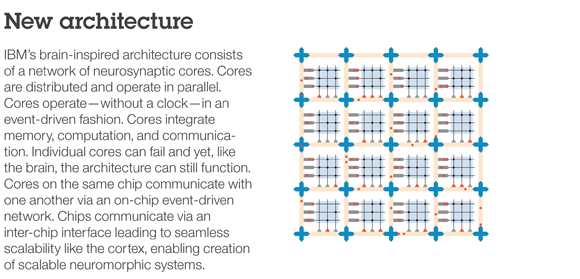
Source: IBM.
While consumer tech devices often focus on incremental changes -- think Apple's upcoming larger iPhone -- IBM (IBM +0.67%) has been busy working on a new chip that processes information like a human brain.
The TrueNorth chip has the potential to vastly change how future computers work, how much energy they use, and what type of tasks they can handle. However, more than a few skeptics question whether IBM has created the most advanced neurosynaptic computer chip, so let's look at exactly what it is and why it's important.
How it works
Here are the specs for the TrueNorth chip:
- Non-von Neumann computer architecture
- 5.4 billion transistors
- 4,096 neurosynaptic cores
- One million neurons and 256 million synapses
- Built on Samsung's 28nm process technology
- Consumes 70mW during operation
Really exciting stuff, right?
Let's boil all this down for those who don't know much about neurons or computer architecture.
For the past 70 years or so, computer chips have processed information in basically the same way--they send data back and forth linearly between a memory chip and processor. This system works well when processing calculations, but when things start getting complex -- say, for facial recognition or sounds -- it's not so great. The back and forth between the memory chip and processor can cause the data to bottleneck and slow down the process.
IBM says TrueNorth achieves cognitive computing, in which the chip mimics a brain's ability for perception, cognition, and action. To do this, the chip emulates the brain's neurons and synapses.
Neurons are brain cells that process electrical signals and send them to other parts of the brain. Human brains have about 100 billion of them. Synapses help those signals connect to other neurons, passing along the information, and we have about 100 trillion of these.
IBM says traditional computers focus on language and analytical thinking, while neurosynaptic chips like TrueNorth "address the senses and pattern recognition." The new chip achieves this, in part, by using cores that have memory, computation, and communication built into the same system.
Here's IBM's description of how it works:

Source: IBM..
Why this is better
The benefit of processing information in this fashion, rather than like traditional computers, is twofold: IBM's TrueNorth can process much more difficult tasks and it uses less energy.
An MIT Technology Review article published earlier this year mentioned Qualcomm's neuromorphic chips, which act in a similar way to TrueNorth. The article said chips like this "encode and transmit data in a way that mimics the electrical spikes generated in the brain as it responds to sensory information." These chips can learn how to recognize an object, like a dog, by seeing one first and then identifying other dogs after that. This comes instead of needing to be programmed and told exactly what a dog is.
The other advantage with TrueNorth is its minimal power consumption. Current computer chips run all the time, whether processing information or not. But IBM's new chip has cores that only run when processing information, then shut off when not being used. The company says TrueNorth uses the same amount of battery power as a hearing aid -- which is just a fraction of the power consumed by today's computer chips.

Source: IBM.
A few skeptics
Not everyone is completely convinced of TrueNorth's capabilities. Yann LeCun, Facebook's director of artificial intelligence research, told The New York Times, "The chip appears to be very limited in many ways, and the performance is not what it seems." He said testing that showed the chip detects pedestrians and cars "won't impress anyone in computer vision or machine learning." He also followed up some of this thoughts in a Facebook post.
Nayaran Srinivasa, a researcher at HRL Laboratories who is working on a similar chip, said in a Wired article, "It's definitely an achievement to make a chip of that scale ... but I think the claims are a bit stretched because there is no learning happening on chip."
But if there's one group that believes in the TrueNorth's potential, it's the U.S. government. The Pentagon's Defense Advanced Research Projects Agency has poured $53 million into the TrueNorth project, run by Cornell University researchers and IBM, since 2008.
IBM's chip is closer to production readiness than others like it, but it's likely years away from any commercial application. The company says TrueNorth could be used for public safety, health monitoring, transportation, and even vision assistance for the blind.
While IBM says TrueNorth processes information like a human brain, and in some respects it does, it appears the chip may have a large learning curve. As it continues to be developed and undergoes more testing, TrueNorth's real-world capabilities should become more apparent.





